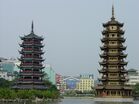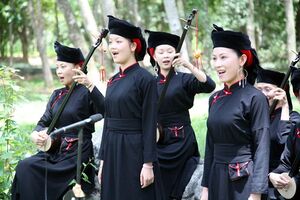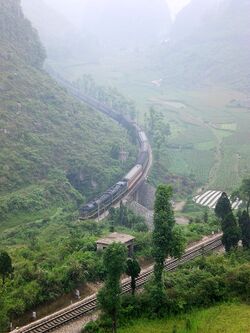قوانغشي
هذا المقال عن منطقة في الصين. للمفهوم الاجتماعي، انظر گوانشي.
گوانگشي ژواڠ، المنطقة المستقلة ذاتياً
Guangxi Zhuang Autonomous Region 广西壮族自治区 | |
|---|---|
| الترجمة اللفظية بالـ Name | |
| • Chinese | 广西壮族自治区 (Guǎngxī Zhuàngzú Zìzhìqū) |
| • Abbreviation | 桂 (Pinyin: Guì) |
| • ژوانگ | Gvangjsih Bouxcuengh Swcigih |
| • يوى Jyutping | Gwong2sai1 Zong3zuk6 Zi6zi6keoi1 |
(clockwise from top)
| |
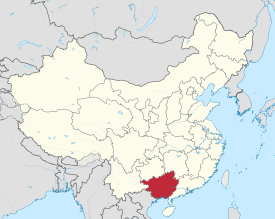 Map showing the location of Guangxi Zhuang Autonomous Region | |
| الإحداثيات: 23°36′N 108°18′E / 23.6°N 108.3°E | |
| البلد | الصين |
| السمِيْ | 广 guǎng - "Wide" 西 xī - "West" حرفياً "Western Expanse" |
| العاصمة (وأكبر مدينة) | نانننگ |
| Divisions | 14 prefectures، 109 counties، 1396 townships |
| الحكومة | |
| • النوع | Autonomous region |
| • الكيان | Guangxi Zhuang Autonomous Regional People's Congress |
| • CCP Secretary | Lu Xinshe |
| • Congress chairman | Lu Xinshe |
| • Gov't Chairman | Lan Tianli |
| • CPPCC chairman | Sun Dawei |
| المساحة | |
| • الإجمالي | 237٬600 كم² (91٬700 ميل²) |
| ترتيب المساحة | 9th |
| أعلى منسوب | 2٬141 m (7٬024 ft) |
| التعداد (2016) | |
| • الإجمالي | 48٬380٬000 |
| • Estimate (2019) | 49٬600٬000 |
| • الترتيب | 11th |
| • الكثافة | 200/km2 (530/sq mi) |
| • ترتيب الكثافة | 20th |
| Demographics | |
| • التركيب العرقي | هان – 62% ژوانگ – 32% ياو – 3% مياو – 1% دونگ – 0.7% ڤيتناميون – 0.6% Gelao – 0.4% |
| • اللغات واللهجات | Zhuang, Yue languages (mainly Cantonese), Southwestern Mandarin, Pinghua |
| ISO 3166 code | CN-GX |
| GDP (2017) | CNY 2.04 trillion[1] USD302.09 billion (17th)(List of Chinese administrative divisions by GDP) |
| • per capita | CNY 41,955 (List of Chinese administrative divisions by GDP per capita) |
| HDI (2018) | ▲ 0.726[2] high · 24th |
| الموقع الإلكتروني | Guangxi Zhuang Autonomous Region (الصينية المبسطة) |
| قوانغشي | |||
|---|---|---|---|
 Guǎngxī in Simplified (top) and Traditional (bottom) Chinese | |||
| الاسم الصيني | |||
| الصينية المبسطة | 广西 | ||
| الصينية التقليدية | 廣西 | ||
| Hanyu Pinyin | Guǎngxī | ||
| البريد | Kwangsi | ||
| المعنى الحرفي | An abbreviation of "Guǎng(nán)xī (Circuit)" | ||
| |||
| Guangxi Zhuang Autonomous Region | |||
| الصينية المبسطة | 广西壮族自治区 | ||
| الصينية التقليدية | 廣西壯族自治區 or 廣西僮族自治區[3] | ||
| Hanyu Pinyin | Guǎngxī Zhuàngzú Zìzhìqū | ||
| البريد | Kwangsi Chuang Autonomous Region | ||
| |||
| Vietnamese name | |||
| Vietnamese | Quảng Tây long: Khu tự trị dân tộc Choang Quảng Tây | ||
| Zhuang name | |||
| Zhuang | Gvangjsih long: Gvangjsih Bouxcuengh Swcigih | ||
| 1957 orthography | Gvaŋзsiƅ long: Gvaŋзsiƅ Bouчcueŋƅ Sɯcigiƅ | ||
| Sawndip | 广西佈僮自治区 廣西佈僮自治區 | ||
| English name | |||
| English | /ˈɡwɑːŋˈsiː/[4] | ||
قوانغشي أو گوانگشي Guangxi (أو گوانگشي ژواڠ، المنطقة المستقلة ذاتياً؛ صينية مبسطة: 广西壮族自治区; صينية تقليدية: 廣西壯族自治區; پنين: Guǎngxī Zhuàngzú Zìzhìqū) هي منطقة مستقلة ذاتياً لشعب ژواڠ في جمهورية الصين الشعبية.
تقع في جنوب الصين، على إمتداد الحدود مع ڤيتنام، وتضاريسها الجبلية، جعلت منها إحدى التخوم الحدودية للحضارة الصينية. حتى القرن العشرين كانت تعتبر أراضية برية مفتوحة. الاسم الحالي "گوانگ" يعني "الامتداد"، وقد ارتبط بالمنطقة منذ تأسيس محافظة گوانگ عام 226. في عهد أسرة يوان مُنحت حالة على مستوى مقاطعة وعام 1949 أعيد تأسيسها كأحد مناطق الأقليات الخمسة المستقلة ذاتياً في الصين.
يُختصر اسم المنطقة إلى 桂 (گوي)، والذي اشتق من مدينة گويلين، العاصمة السابقة، مركز لثقافة، سياسة وتاريخ گوانگشي، والمدينة الرئيسية الحالية في المنطقة المستقلة ذاتياً.
الجغرافيا
تقع گوانگشي في المنطقة الجنوبية من البلاد، تحدها يوننان من الغرب، گويژو من الشمال، هونان من الشمال الشرقي، وگوانگدونگ من الجنوب الشرقي. وتحدها أيضاً ڤيتنام من الجنوب الغربي وخليج تونكين من الجنوب.
الكثير من الأنهار تقطع الوديان عبر الجبال. معظم هذه الأنهار يشكل حوض روافد النهر الغربي:
| منظومة نهر شيجيانگ (يشير الخط المائل إلى الأنهار الواقعة خارج گوانگشي) | ||||
|---|---|---|---|---|
| 贺江 نهر هـِه | 西江 نهر شي | |||
| 漓江 نهر ليجيانگ | 桂江 نهر گوي | |||
| 北盘江 نهر بيپان | 红水河 نهر هونگشوي | 黔江 نهر تشيان | 浔江 نهر شون | |
| 南盘江 نهر نانپان | ||||
| 融江 نهر رونگ | 柳江 نهر ليو | |||
| 龙江 نهر لونگ | ||||
| 右江 نهر يو | 邕江 نهر يونگ | 郁江 نهر يو | ||
| 左江 Zuo River | ||||
لگوانگشي شريط ساحلي على خليج تونكين. ومن أهم الموانئ البحرية بيهاي، تشينژو وفانگتشنگگنگ
تتمتع گوانگشي بمناخ شبه إستوائي. بصفة عامة يكون الصيف طويل وحار. متوسط درجات الحرارة من 17 إلى 23 °س، بينما يتراوح متوسط هطول الأمطار من 1250 إلى 1750 مم.
المدن الرئيسية تضم: نانننگ، بيهاي، گويلين، ليوژو.
من أشهر البلدات: لونگمن، سانجيانگ، يانگشو.
التقسيم الاداري
تنقسيم گوانگشي إلى أربعة عشر مدينة بمستوى محافظة، ستة وخمسين ناحية، أربعة وثلاثين ميدرية، إثنى عشر منطقة عرقية ذاتية الحكم وسبعة مدينة بمستوى ناحية. الأربعة عشر مدينة بمستوى محافظة هي:
| الخريطة | # | الاسم | هانزي | هانيو پنين | ژواڠ |
|---|---|---|---|---|---|
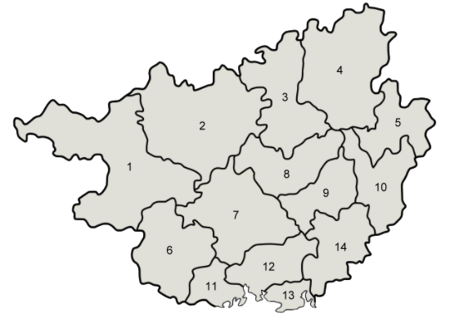
| |||||
| 1 | بايسه | 百色市 | Bǎisè Shì | Baksaek Si | |
| 2 | هـِچي | 河池市 | Héchí Shì | Hozciz Si | |
| 3 | ليوژو | 柳州市 | Liǔzhōu Shì | Liujcouh Si | |
| 4 | گويلين | 桂林市 | Guìlín Shì | Gveilinz Si | |
| 5 | هژو | 贺州市 | Hézhōu Shì | Hohcouh Si | |
| 6 | چونگزو | 崇左市 | Chóngzuǒ Shì | Cungzcoj Si | |
| 7 | نانننگ | 南宁市 | Nánníng Shì | Namzningz Si | |
| 8 | لايبين | 来宾市 | Láibīn Shì | Leizbingz Si | |
| 9 | گويگانگ | 贵港市 | Guìgǎng Shì | Gveigangj Si | |
| 10 | ووژو | 梧州市 | Wúzhōu Shì | Ngouzcouh Si | |
| 11 | فانچچنگگانگ | 防城港市 | Fángchénggǎng Shì | Fangzcwngzgangj Si | |
| 12 | تشينژو | 钦州市 | Qīnzhōu Shì | Ginhcouh Si | |
| 13 | Beihai | 北海市 | Běihǎi Shì | Baekhaij Si | |
| 14 | يولين | 玉林市 | Yùlín Shì | Yoglinz Si |
احتياطيات البوكسايت
في سبتمبر 2007، صرحت وزارة التجارة الصينية بأنها عثرت على 120 مليون طن من احتياطيات البوكسايت الجديدة في گوانگشي. قالت الوزارة أن الاحتاطيات الجديدة، والتي تقع في چونگژو في المنطقة الجنوبية من يوجيانگ، تحتوي على بوكسايت عالي الجدة، المادة الخام المستخدمة في صنع الألومنيوم. حاليأً، تبلغ احتياطيات البوكسايت المؤكدة في گوانگشي حوالي مليون طن، مما يجعلها واحدة من أكبر مصادر البوكسايت في البلاد.
الديمغرافيا
| Year | Pop. | ±% |
|---|---|---|
| 1912[5] | 7٬879٬000 | — |
| 1928[6] | 13٬648٬000 | +73.2% |
| 1936-37[7] | 13٬385٬000 | −1.9% |
| 1947[8] | 14٬636٬000 | +9.3% |
| 1954[9] | 19٬560٬822 | +33.6% |
| 1964[10] | 20٬845٬017 | +6.6% |
| 1982[11] | 36٬420٬960 | +74.7% |
| 1990[12] | 42٬245٬765 | +16.0% |
| 2000[13] | 43٬854٬538 | +3.8% |
| 2010[14] | 46٬026٬629 | +5.0% |
The Han Chinese are the largest ethnic group. Of these, the main subgroups are those that speak Yue and Southwestern Mandarin varieties of Chinese.
Guangxi has over 14 million Zhuangs, the largest minority ethnicity of China. Over 90 percent of Zhuang in China live in Guangxi, especially in the central and western regions. There is also a significant number of both Dong and Miao minority peoples. Other ethnic groups include Yao, Hui, Yi (Lolo), Shui, and Gin (Vietnamese).
الدين
The predominant religions in Guangxi among the Han Chinese are Chinese folk religions, Taoist traditions and Chinese Buddhism. The large Zhuang population mostly practices the Zhuang folk religion centered around the worship of their ancestral god Buluotuo (布洛陀). According to surveys conducted in 2007 and 2009, 40.48% of the population believes and is involved in ancestor veneration, while 0.26% of the population identifies as Christian.[15]
The reports did not give figures for other types of religion; 59.26% of the population may be either irreligious or involved in worship of nature deities, Buddhism, Confucianism, Taoism, folk religious sects. The Yao, another numerous ethnic group inhabiting the province, mostly practices a form of indigenised and conservative Taoism.
Economy
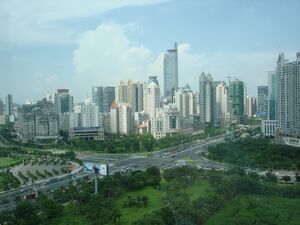
Important crops in Guangxi include rice, maize and sweet potatoes. Cash crops include sugar cane, peanuts, tobacco, and kenaf.
85 percent of the world's star anise is grown in Guangxi. It is a major ingredient in the antiviral oseltamivir.[16]
Guangxi is one of China's key production centers for nonferrous metals. The province holds approximately 1/3 of all tin and manganese deposits in China.[17]
Liuzhou is the main industrial center and is a major motor vehicle manufacturing center. General Motors have a manufacturing base here in a joint venture as SAIC-GM-Wuling Automobile. The city also has a large steel factory and several related industries. The local government of Guangxi hopes to expand the province's manufacturing sector, and during the drafting of China's Five Year Plan in 2011, earmarked 2.6 trillion RMB for investment in the province's Beibu Gulf Economic Zone(See Below).[17]
In recent years Guangxi's economy has languished behind that of its wealthy neighbor and twin, Guangdong. Guangxi's 2017 nominal GDP was about 2039.63 billion yuan (US$302.09 billion) and ranked 17th in China. Its per capita GDP was 38,102 yuan (US$5,770).[18]
Due to its lack of a major manufacturing industry in comparison to other provinces, Guangxi is the fourth most energy efficient province in China, helping to further boost its green image.[19]
Economic and technological development zones

- Beihai Silver Beach National Tourist Holiday Resort
- Beihai Export Processing Zone
Approved by the State Council, Beihai Export Processing Zone (BHEPZ) was established in March 2003. Total planned area is 1.454 square kilometres (0.561 sq mi). The first phase of developed area is 1.135 square kilometres (0.438 sq mi). It was verified and accepted by Customs General Administration and eight ministries of the state, on December 26, 2003. It is the Export Processing Zone nearest to ASEAN in China and also the only one bordering the sea in western China. It is situated next to Beihai Port.[20]
- Dongxing Border Economic Cooperation Area
- Guilin National New & Hi-Tech Industrial Development Zone
Guilin Hi-Tech Industrial Development Zone was established in May 1988. In 1991, it was approved as a national-level industrial zone. It has an area of 12.07 square kilometres (4.66 sq mi). Encouraged industries include electronic information, biomedical, new materials and environmental protection.[21]
- Nanning Economic & Technological Development Area
Established in 1992, Nanning Economic and Technological Development Zone was approved to be a national level zone in May 2001. Its total planned area of 10.796 square kilometres (4.168 sq mi). It is located in the south of Nanning. It has become the new developing zone with fine chemical engineering, auto parts, aluminum processing, biological medicine and other industries.[22]
- Nanning National Hi-Tech Industrial Development Zone
Nanning Hi-Tech Industrial Development Zone was established in 1988 and was approved as a national-level industrial zone in 1992. The zone has a planned area of 43.7 square kilometres (16.9 sq mi), and it encourages industries that do electronic information, bioengineering and pharmaceutical, mechanical and electrical integration and new materials industry.[23]
- Pingxiang Border Economic Cooperation Zone
In 1992, Pinxiang Border Economic Cooperation Zone was established. It has a total area of 7.2 square kilometres (2.8 sq mi). It focuses on development of hardware mechanical and electrical products, daily-use chemical processing, the services, and international logistics-based storage and information industry.[24]
- Yongning Economic Development Zone
Investment
Seventy-one Taiwanese ventures started up in Guangxi in 2007, with contracts bringing up to US$149 million of investment, while gross exports surpassed US$1 billion. There are a total of 1182 Taiwan ventures in Guangxi, and by the end of 2006, they have brought a total of US$4.27 billion of investment into the autonomous region. During the first half of 2007, 43 projects worthy of RMB2.6 billion (US$342 million) have already been contracted between Guangxi and Taiwan investors. Cooperation between Guangxi and Taiwan companies mainly relates to manufacturing, high-tech electronic industries, agriculture, energy resources and tourism.[بحاجة لمصدر]
Power
Guangxi Power Grid invested 180 million yuan in 2007 in projects to bring power to areas that still lacked access to electricity. The areas affected include Nanning, Hechi, Bose and Guigang. Around 125,000 people have gained access to electricity. The money has been used to build or alter 738 10-kilovolt distribution units with a total length of wire reaching 1,831.8 kilometers.[بحاجة لمصدر]
Due to lack of investment in construction in the power grid net in rural areas, more than 400 villages in Guangxi Province were not included in the projects. Around 500,000 cannot participate in the policy known as "The Same Grid, the Same Price." Guangxi Power Grid will invest 4.6 billion yuan in improving the power grid during the 11th Five Year Plan.[بحاجة لمصدر]
Guangxi Power Grid has invested 2.5 billion yuan in building electric power system in the first half of 2007. Of the total investment, 2.3 billion yuan has been put into the project of the main power grid. So far, four new transformer substations in Guangxi are in various stages of completion. Wenfu substation went into operation in the city of Hechi in January 2007, and since then it has become a major hub of the electrical power system of the surrounding three counties. When Cangwu substation was completed, it doubled the local transformer capacity. In June 2007, the new substation in Chongzuo passed its operation tests. And in the same month, Qiulong commenced production too. This shall support the power supply system of Qiulong City, as well as the northern part of Guangxi province, and facilitate the nationwide project to transmit power from west to east.[بحاجة لمصدر]
Beibu Gulf Economic Zone
In late February 2008, the central government approved China's first international and regional economic cooperation zone in Guangxi. The construction of the Beibu Gulf Economic Zone began in 2006. With the approval, the Beibu Gulf Economic Zone will be formally incorporated into national development strategies.[بحاجة لمصدر]
The Beibu Gulf Economic Zone covers six coastal cities along the Beibu Gulf. It integrates the cities of Nanning, the region's capital, Beihai, Qinzhou, Fangchenggang, Chongzuo and Yulin. The state will adopt policies and measures to support mechanism innovation, rational industry layout and infrastructure construction in the Beibu Gulf Economic Zone.[بحاجة لمصدر]
Guangxi has pledged a 100 billion yuan (US$14 billion) investment over the next five years[when?] for building and repairing 2,500 km (1,600 mi) railways to form a network hub in the area. Beibu Gulf Zone will serve as the logistics base, business base, processing and manufacturing base and information exchange center for China-ASEAN cooperation. Beibu Gulf Zone promises broad prospects for further development and its growth potential is rapidly released. But the shortage of talent and professionals in petrochemicals, iron and steel, electricity, finance, tourism, port planning, logistics and marine industries are bottlenecks.[بحاجة لمصدر]
The regional government is also working on speeding up key cooperation projects including transportation, the marine industry, agriculture, forestry, fisheries, energy development, cross-border tourism, and environmental protection. Beibu Gulf has already attracted a number of major projects such as Qinzhou oil refinery projects and Stora Enso, a Fortune 500 forest products company based in Finland. In January 2008 trade import and export in the Beibu Gulf zone exceeded US$1.3 billion, a record high.[بحاجة لمصدر]
احتياطيات البوكسيت
In September 2007, China's Ministry of Commerce said that it has found 120 million tons of new bauxite reserves in Guangxi. The ministry said that the new reserves, which are located in Chongzhou in the southern region of Youjiang, have a very high-quality of bauxite, a raw material for making aluminum. Currently, the proven reserves of bauxite in Guangxi are about 1 billion tons, making the province one of the country's biggest bauxite sources.
النقل
السكة الحديدية
المناطق الشقيقة
 – Kumamoto Prefecture (1982)
– Kumamoto Prefecture (1982) – Carinthia (1987)
– Carinthia (1987) – Rio Grande do Norte (1995)
– Rio Grande do Norte (1995) – Newport (Formerly) (1996-2019)
– Newport (Formerly) (1996-2019) – Voronezh Oblast (1997)
– Voronezh Oblast (1997) – Montana (1999)[25]
– Montana (1999)[25] – Poitou-Charentes (2002)
– Poitou-Charentes (2002) – Surat Thani Province (2004)
– Surat Thani Province (2004) – Podkarpackie (2015)
– Podkarpackie (2015)
الهامش
- ^ 广西壮族自治区2017年国民经济和社会发展统计公报 [Statistical Communiqué of Guangxi on the 2017 National Economic and Social Development] (in الصينية). Statistical Bureau of Guangxi. 2018-04-26. Archived from the original on 2018-06-22. Retrieved 2018-06-22.
- ^ "Sub-national HDI - Subnational HDI - Global Data Lab". globaldatalab.org. Retrieved 2020-04-17.
- ^ "Archived copy". Archived from the original on 2016-12-21. Retrieved 2016-12-07.
{{cite web}}: CS1 maint: archived copy as title (link) - ^ "Guangxi" Archived 2018-04-08 at the Wayback Machine. Collins English Dictionary.
- ^ 1912年中国人口. Archived from the original on 24 September 2015. Retrieved 6 March 2014.
- ^ 1928年中国人口. Archived from the original on 24 September 2015. Retrieved 6 March 2014.
- ^ 1936-37年中国人口. Archived from the original on 24 September 2015. Retrieved 6 March 2014.
- ^ 1947年全国人口. Archived from the original on 13 September 2013. Retrieved 6 March 2014.
- ^ 中华人民共和国国家统计局关于第一次全国人口调查登记结果的公报. National Bureau of Statistics of China. Archived from the original on 2009-08-05.
- ^ 第二次全国人口普查结果的几项主要统计数字. National Bureau of Statistics of China. Archived from the original on 2012-09-14.
- ^ 中华人民共和国国家统计局关于一九八二年人口普查主要数字的公报. National Bureau of Statistics of China. Archived from the original on 2012-05-10.
- ^ 中华人民共和国国家统计局关于一九九〇年人口普查主要数据的公报. National Bureau of Statistics of China. Archived from the original on 2012-06-19.
- ^ 现将2000年第五次全国人口普查快速汇总的人口地区分布数据公布如下. National Bureau of Statistics of China. Archived from the original on 2012-08-29.
- ^ "Communiqué of the National Bureau of Statistics of People's Republic of China on Major Figures of the 2010 Population Census". National Bureau of Statistics of China. Archived from the original on 2013-07-27.
- ^ أ ب ت China General Social Survey 2009, Chinese Spiritual Life Survey (CSLS) 2007. Report by: Xiuhua Wang (2015, p. 15) Archived 2015-09-25 at the Wayback Machine
- ^ http://epaper.gxnews.com.cn/ngjb/html/2009–05/07/node_303.htm[dead link]
- ^ أ ب "Archived copy". Archived from the original on 2011-10-08. Retrieved 2011-11-01.
{{cite web}}: CS1 maint: archived copy as title (link) - ^ https://www.ceicdata.com/en/china/gross-domestic-product-per-capita/gross-domestic-product-per-capita-guangxi
- ^ "The China Perspective | Guangxi Economic and Industry Profile/". Archived from the original on 2011-06-02. Retrieved 2011-05-27.
- ^ "RightSite.asia | Beihai Export Processing Zone". Archived from the original on 2010-06-12. Retrieved 2010-05-27.
- ^ "RightSite.asia | Guilin National New & Hi-Tech Industrial Development Zone". Archived from the original on 2010-06-18. Retrieved 2010-05-28.
- ^ "RightSite.asia | Nanning Economic & Technological Development Area". Archived from the original on 2010-06-12. Retrieved 2010-05-28.
- ^ "RightSite.asia | Nanning Hi-Tech Industrial Development Zone". Archived from the original on 2010-06-10. Retrieved 2010-05-28.
- ^ "RightSite.asia | Pingxiang Border Economic Cooperation Zone". Archived from the original on 2010-06-11. Retrieved 2010-05-31.
- ^ "An IR View: Clear goals essential to sister city relationship". Helena Independent Record (in الإنجليزية). Retrieved 2020-10-09.
وصلات خارجية
قالب:Zhuang autonomy in the People's Republic of China
خطأ استشهاد: وسوم <ref> موجودة لمجموعة اسمها "note"، ولكن لم يتم العثور على وسم <references group="note"/>
- Pages using gadget WikiMiniAtlas
- CS1 uses الصينية-language script (zh)
- CS1 الصينية-language sources (zh)
- CS1 uses اليابانية-language script (ja)
- Articles with dead external links from January 2020
- Short description is different from Wikidata
- Articles containing صينية-language text
- Articles containing Zhuang-language text
- Coordinates on Wikidata
- Articles containing ڤيتنامية-language text
- Articles containing Pinyin-language text
- Articles with unsourced statements from July 2014
- Articles with hatnote templates targeting a nonexistent page
- Vague or ambiguous time from July 2014
- المقالات needing additional references from December 2011
- كل المقالات needing additional references
- گوانگشي
- المناطق المستقلة ذاتياً في جمهورية الصين الشعبية
- خليج تونكين
- دول وأقاليم تأسست في 1958

